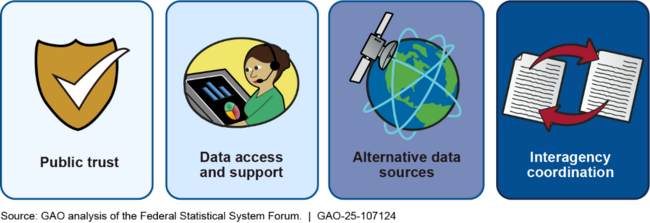Highlights of a Forum: Expert Views on the Federal Statistical System
Fast Facts
Federal statistical data is used to calculate funding to states, to understand economic issues and population changes, and more. This data is primarily maintained across 16 agencies and units and over 100 statistical programs, operating in coordination as "the federal statistical system."
During our August 2024 forum, experts identified challenges with the system—including in data privacy, quality, and accuracy, and meeting users' data needs.
They suggested improvements to help address these issues, while also
- Expanding data access and protecting privacy
- Encouraging use of innovative data sources
- Strengthening coordination among the agencies

Highlights
What GAO Found
The federal statistical system faces a critical juncture as it works to modernize and adapt to a rapidly changing data landscape, driven by increasing demand for timely, detailed, and relevant information amid declining survey response rates and rising data collection costs. During a forum GAO held in 2024, experts and stakeholders identified various challenges and opportunities facing the system across a range of topics (see figure).
Figure: Key Topics Discussed at the Forum on the U.S. Statistical System

Public Trust. The system faces growing challenges in building and maintaining public trust, particularly as it navigates emerging risks to privacy and confidentiality, according to participants. Suggestions for improving public trust include promoting transparency and advancing privacy enhancing technologies.
Data Access and Support. According to participants, the system faces challenges in meeting the needs of a diverse user base, from highly technical researchers to non-technical data users, and in facilitating access to data products. The system also faces challenges in offering appropriate guidance and tools tailored to users. Potential options for addressing these challenges include expanding data user outreach and training, as well as developing a streamlined data access portal with enhanced analytic capabilities and support.
Alternative Data Sources. Participants highlighted key benefits that alternative data sources—such as private sector data and administrative records—offer for improving federal statistical production and better meeting the needs of data users. Yet participants said that statistical agencies face significant challenges in using alternative data, including legal barriers and dependance on data providers. Participants said that addressing these issues will require strong data security and incentives for provider participation, among other things.
Interagency Coordination. Participants identified effective interagency coordination as key for modernizing statistical production, facilitating outreach to users, and alleviating resource constraints. However, the decentralized design of the system and the absence of a shared framework for interagency data sharing hinder coordination among agencies, creating barriers to data sharing. Suggestions for strengthening interagency coordination include modernizing legislation and establishing shared data infrastructure.
Why GAO Did This Study
The federal statistical system includes 16 statistical agencies and units and over 100 statistical programs that produce data critical for program design, monitoring, and evaluation of federal programs. These data are vital for decisions that directly affect the public. These include the allocation of federal funding to states and localities and the production of key national statistics on health, demographics, and the economy. However, the system faces long-standing challenges that may prevent these agencies from effectively producing timely and accurate information.
In August 2024, GAO held a forum on the federal statistical system. The participants discussed what factors affect the system’s ability to (1) build and maintain public trust, (2) meet the needs of its users, (3) sustain and modernize its data collection, and (4) engage in effective interagency coordination. This report is the first in a body of work to assess opportunities to reduce fragmentation, overlap, and duplication in the system, consistent with a statutory provision for GAO to, among other things, routinely investigate government programs to identify duplicative goals and activities.
Participants included 29 experts and stakeholders from the federal statistical system, other federal agencies, state and local government agencies, a non-U.S. national statistical office, an international organization, academic institutions, the private sector, and professional organizations. GAO also interviewed officials from federal and state government agencies. Participants reviewed a draft of this report, and comments were incorporated as appropriate. Views expressed during the proceedings do not represent the opinions of all participants, their affiliated organizations, or GAO.
For more information, contact Jared Smith at SmithJB@gao.gov.
